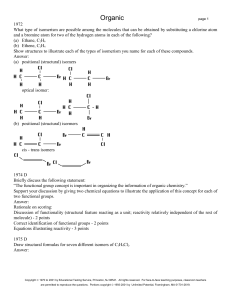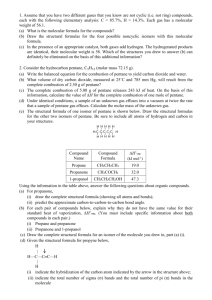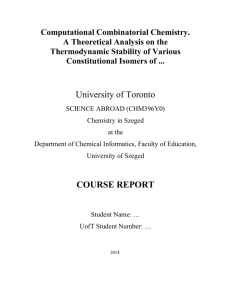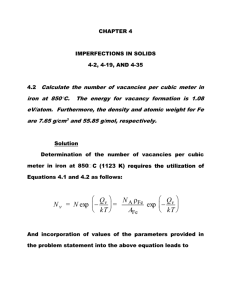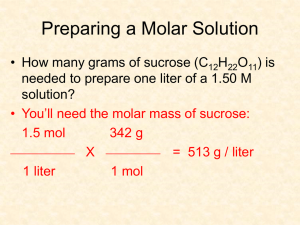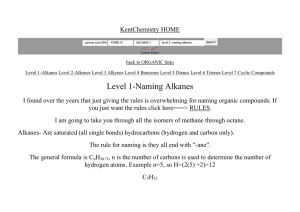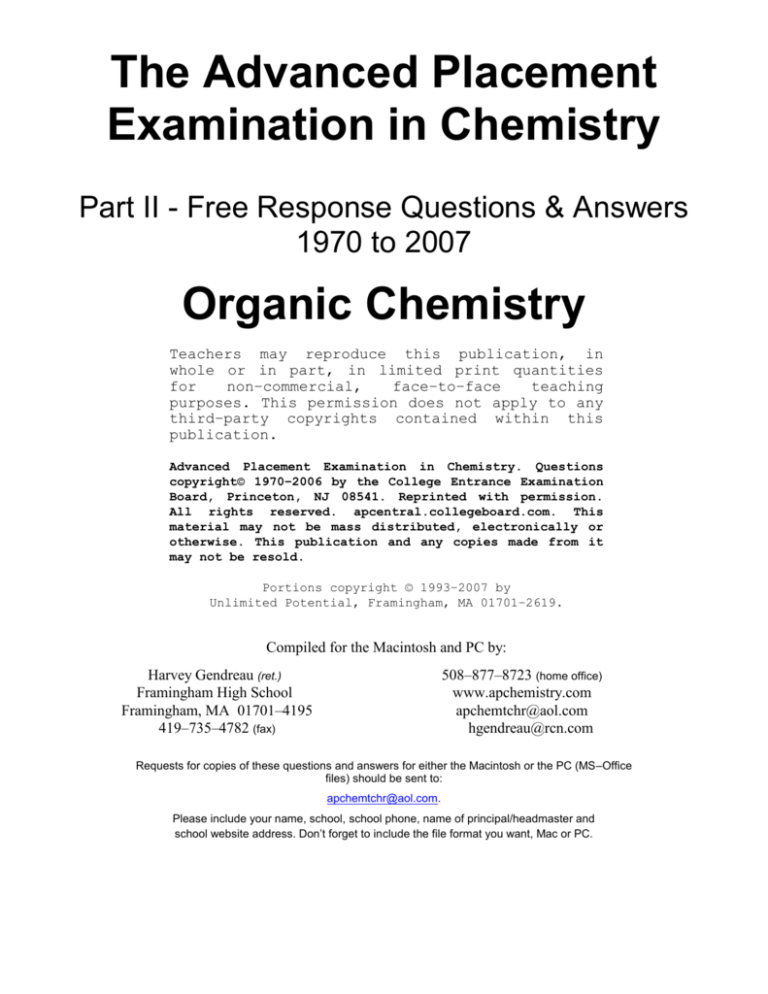
The Advanced Placement
Examination in Chemistry
Part II - Free Response Questions & Answers
1970 to 2007
Organic Chemistry
Teachers may reproduce this publication, in
whole or in part, in limited print quantities
for
non–commercial,
face–to–face
teaching
purposes. This permission does not apply to any
third–party copyrights contained within this
publication.
Advanced Placement Examination in Chemistry. Questions
copyright© 1970–2006 by the College Entrance Examination
Board, Princeton, NJ 08541. Reprinted with permission.
All rights reserved. apcentral.collegeboard.com. This
material may not be mass distributed, electronically or
otherwise. This publication and any copies made from it
may not be resold.
Portions copyright © 1993–2007 by
Unlimited Potential, Framingham, MA 01701–2619.
Compiled for the Macintosh and PC by:
Harvey Gendreau (ret.)
Framingham High School
Framingham, MA 01701–4195
419–735–4782 (fax)
508–877–8723 (home office)
www.apchemistry.com
apchemtchr@aol.com
hgendreau@rcn.com
Requests for copies of these questions and answers for either the Macintosh or the PC (MS–Office
files) should be sent to:
apchemtchr@aol.com.
Please include your name, school, school phone, name of principal/headmaster and
school website address. Don’t forget to include the file format you want, Mac or PC.
Organic
page 2
1972
What types of isomerism are possible among the molecules that can be obtained by substituting a chlorine atom
and a bromine atom for two of the hydrogen atoms in each of the following?
(a) Ethane, C2H6
(b) Ethene, C2H4
Show structures to illustrate each of the types of isomerism you name for each of these compounds.
Answer:
(a) positional (structural) isomers
optical isomer:
(b) positional (structural) isormers
cis - trans isomers
1974 D
Briefly discuss the following statement:
“The functional group concept is important in organizing the information of organic chemistry.”
Support your discussion by giving two chemical equations to illustrate the application of this concept for each of
two functional groups.
Answer:
Rationale on scoring:
Discussion of functionality (structural feature reacting as a unit; reactivity relatively independent of the rest of
molecule) - 2 points
Correct identification of functional groups - 2 points
Equations illustrating reactivity - 3 points
1975 D
Draw structural formulas for seven different isomers of C3H4Cl2.
Answer:
Organic
page 3
1977 D
Write structural formulas for two stable isomers X and Y that have the molecular formula C2H4O2. Select a
physical property and a chemical property that would distinguish between the two isomers in the laboratory.
Explain.
Answer:
Correct distinguishing physical property: solubility, odor, boiling point, pH of aqueous solution, etc.
Correct distinguishing chemical property: type of reaction, acid or reducing property, conductivity, or pH of
solution, etc.
1978 D
Dehydration of 3-hexanol yields a mixture of four isomers each with the molecular formula C6H12. Draw
structures of the four isomers and name each of them.
Answer:
trans-3-hexene
cis-3-hexene
trans-2-hexene
cis-2-hexene
1981 D
Assume that you have two different gases that you know are not cyclic (i.e. not ring) compounds, each with the
following elementary analysis: C = 85.7%, H = 14.3%. Each gas has a molecular weight of 56▒1.
(a) What is the molecular formula for the compounds?
Organic
page 4
(b) Draw the structural formulas for the four possible noncyclic isomers with this molecular formula.
(c) In the presence of an appropriate catalyst, both gases add hydrogen. The hydrogenated products are
identical, their molecular weight is 58. Which of the structures you drew to answer (b) can definitely be
eliminated on the basis of this additional information?
Answer:
56g
0.857 g C 1 mol C
4 mol C
56 g
0.143 g H 1 mol H
8 mol H
(a)
1 mol cmpd 1g cmpd 12 g C 1 mol cmpd
1 mol cmpd 1g cmpd 1.01 g H 1 mol cmpd
molecular formula: C4H8
(b)
(c) The last formula in Part (b) can be eliminated (2-methyl-1-propene).
1998 D
Answer each of the following using appropriate chemical principles.
(c) Dimethyl ether, H3C-O-CH3, is not very soluble in water. Draw a structural isomer of dimethyl ether that is
much more soluble in water and explain the basis of its increased water solubility.
In each case, justify your choice.
Answer
H| H|
(c) H–O–C–C–H
The O-H bond in ethyl alcohol is very polar and will allow the molecule to be attracted to
|
|
H H
and dissolve in the polar water.
2002 B
Consider the hydrocarbon pentane, C5H12 (molar mass 72.15 g).
(a) Write the balanced equation for the combustion of pentane to yield carbon dioxide and water.
(b) What volume of dry carbon dioxide, measured at 25˚C and 785 mm Hg, will result from the complete
combustion of 2.50 g of pentane?
(c) The complete combustion of 5.00 g of pentane releases 243 kJ of heat. On the basis of this information,
calculate the value of ∆H for the complete combustion of one mole of pentane.
(d) Under identical conditions, a sample of an unknown gas effuses into a vacuum at twice the rate that a
sample of pentane gas effuses. Calculate the molar mass of the unknown gas.
(e) The structural formula of one isomer of pentane is shown below. Draw the structural formulas for the other
two isomers of pentane. Be sure to include all atoms of hydrogen and carbon in your structures.
Answer:
(a) C5H12 + 8 O2 5 CO2 + 6 H2O
Organic
page 5
1 mol C5H12
5 mol CO2
(b) 2.50 g C5H12 72.15 g C H
1
mol C5H12 = 0.173 mol CO2
5 12
L•atm
(0.173 mol)(0.0821 mol•K )(298 K)
nRT
V= P =
=
(785/760 atm)
4.10 L
-243 kJ
72.15 g
(c) 5.00 g 1 mol = -3510 kJ/mol
r1
(d) r =
2
M2
r1
;
M1
2r1 =
M2
72.15 ; M2 = 18.0
(e)
2003 D (repeated in bonding)
Compound
Name
Compound
Formula
∆H˚vap
(kJ mol-1)
Propane
CH3CH2CH3
19.0
Propanone
CH3COCH3
32.0
1-propanol
CH3CH2CH2OH
47.3
Using the information in the table above, answer the following questions about organic compounds.
(a) For propanone,
(i) draw the complete structural formula (showing all atoms and bonds);
(ii) predict the approximate carbon-to-carbon-to-carbon bond angle.
(b) For each pair of compounds below, explain why they do not have the same value for their standard heat of
vaporization, ∆H˚vap. (You must include specific information about both compounds in each pair.)
(i) Propane and propanone
(ii) Propanone and 1-propanol
(c) Draw the complete structural formula for an isomer of the molecule you drew in, part (a) (i).
(d) Given the structural formula for propyne below,
H
|
H—C—CC—H
|
H
(i) indicate the hybridization of the carbon atom indicated by the arrow in the structure above;
(ii) indicate the total number of sigma () bands and the total number of pi (π) bonds in the molecule
Answer:
Organic
page 6
(a) (i)
(ii) 120˚
(b) (i) propane, 26 electrons, molar mass = 44
propanone, 32 electrons, molar mass = 58
higher # electrons means larger van der Waal forces, larger molar mass means a slower molecule, the
oxygen creates a polar molecule and dipol–dipole interactions
(ii) 1-propanol has an –OH which creates a site for hydrogen bonding with other –OH on adjacent
molecules increasing intermolecular forces that must be overcome in order to vaporize the liquid.
(c)
(d) (i) sp
(ii) 6 sigma, 2 pi

